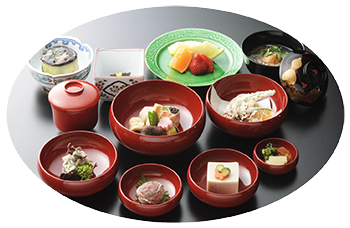
Traditional vegetarian cooking


日本料理の中にも、ベジタリアンの方々が提唱してこられた心と体の健康のための菜食料理があります。
それが『精進料理』です。
There is a method of vegetarian cooking which vegetarians have proposed for a healthy mind and body in Japanese cooking.
This is “Shojinryori”
Shojinryori
精進料理とは…
『精進』という言葉はサンスクリット語(古代インド語・梵語)でvirya(ヴィリヤ)の訳語です。『精勤(せいごん)』とも訳され、本来の意味は、『精進を込めて悪心、悪行をおさえ、善行を修すること』を言います。仏道に於いて精進という言葉は悟りを見極めるための大きな過程の大行とも言えます。その『精進』の実践方法の一つに、美食(魚介肉類)を戒め、粗食(野菜、根菜、海草類)であれということがあります。また、『精進』は清らかに仏道を求める意とも相まって、なまぐさ物(魚介肉類等)を食べないという風習になっていきました。
この『精進』の精神に基づき、仏教が六世紀末に中国より渡来して以来、修行僧の食物にきびしい戒律を加えて各宗派独特の精進料理が生まれ、長い年月と幾多の変化を経て現在に至っています。中でも鎌倉時代中期に、禅宗の僧が『調理し供養する者、戴く者の礼儀作法』として、『典座教訓(てんぞきょうくん)』を著し、この『典座教訓(てんぞきょうくん)』が今日の日本料理の典型となり、お茶の懐石料理もここから生まれました。また、家庭に於ける惣菜料理の源ともなったと言われています。
この精進料理の考え方が、現在の日本食の基礎となっているからこそ、一般的に日本食が健康食として世界的に注目されてるといっても決して過言ではありません。
精進料理は、特に季節感を重んじ、五法(生ま、煮る、焼く、揚げる、蒸す)・五色(青、黄、赤、白、黒(紫))・五味(しょうゆ、塩、甘味、酢、辛味(からし、しょうが、わさびなど))の組み合わせを重視しています。素材そのものに鳥獣魚肉のように蛋白質のうま味がないので、おのずと手数をかけて造る料理が多いため、調理する者の『手間を食べていただく料理』であり、さらに調理する者の『愛情を食べていただく』料理です。
精進料理は、使用される食材からも、様々なレベルの『ベジタリアン(菜食主義者)』の方々のニーズにお答えできる代表的な日本食であると思います。
『精進料理』といえば、『お寺での料理』・『弔事のの料理』という印象が強く、一般の方々の認識は薄いのが現状ではありますが、この機会に『精進料理』にご注目いただければ幸いです。
Shojinryori is…
“The word ”Shojin” is Sanskrit(ancient Indian languages, Bongo), translation of virya.
It is also translated as “Seigon” and primarily means to limit nausea and wrongful acts by devoring and doing good deeds. In Buddhism, the word “Shojin” could mean an excellent deed in an important course to achieve enlightenment. One practice for the “Shojin” is to rebuke epicurean foods such as meat and fish, and to eat abstemious meals such as vegetables, root vegetables, and seaweed. And the custom of not eating foods that smell fishy has been ordinary because “Shoujin” means seeking Buddhism purely.
Since Buddhism, which includes the spirit of “Shojin”, has been introduced into Japan from China at the end of the sixth century, the unique “Shojin ryori” by each religion has started with strict principles about foods for ascetic monks. After a million years and all sorts of changes, it has led to the present. A Zen priest wrote, “Tenzokyokun” epitomizes Japanese Cuisine today and tea-ceremony dishes had started from that. That is also described as an origin to daily dishes at home.
This method of Shojinryori forms the basis of today’s Japanese food. Therefore, it may be no exaggeration to say that Japanese food has in general attracted worldwide attention as a healthy food.
In Shojin ryori, we especially value a sense of the season. And we value a combination of five cooking methods(raw, boiling, grilling, frying, and steaming), five colors(blue, yellow, red, white, and black/purple), and five tastes(soy sauce, salt, sweet, vinegar, and hot flavors, such as mustard, ginger, green horseradish paste and so on). Because foods of Shojin ryori themselves have less flavor of proteinic than chicken or fish, most of them are deliberately cooked. So Shojin ryori is a dish that you can enjoy that is “fiddly cooked by chefs” and also “cooked with chef’s love and kindness”.
We think that Shojinryori is a representative Japanese food which can meet the varying levels of vegetaians’needs with their ingredients.
People usually associate “Shojin ryori” with a “meal at a temple” or “meal at a funeral” and therefore there is still little understanding of Shojinryori in a public setting.
